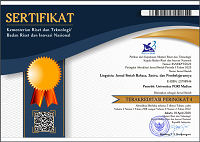Morphological Awareness: Students’ Proficiency in Analyzing Derivational Affixes in English
Abstract
This paper examined students’ proficiency in analyzing derivational affixes in English. The objective of this research was to discover how far the students’ capability in analyzing errors of prefixes and suffixes in English sentences. The researchers limited this study to focus only on derivational affixes. In order to obtain the data, students were tested. The participants of this research were undergraduate students of the English education department at STKIP Pamane Talino, West Kalimantan. The researchers used a descriptive qualitative method to analyze the data. The results showed the average of students’ proficiency in analyzing prefixes and suffixes in sentences was 68.57%. More specifically, seven students (33.33%) belonged to the “excellent” category, seven students (33.33%) belonged to the “very good” category, four students (19.04%) were categorized as a “good” category, two students (9.52%) were classified as a “fair” category, and one student (4.76%) belonged to the “poor” category.
Keywords
Full Text:
PDFReferences
Abdullah, M. (2017). Processes of derivational affixes of Lamaholot language mostly used in East Solor sub-district East Flores regency. SMCC Higher Education Research Journal, 3(1), 1-1.
Adisutrisno, D. W. (2013). English morphology. Magister Scientiae, (33), 1-20.
Alhasibunur, A. (2018). The analysis of morphological process of students' English utterances. JOLLT Journal of Languages and Language Teaching, 4(2), 47-54.
Alqahtani, M. (2015). The importance of vocabulary in language learning and how to be taught. International journal of teaching and education, 3(3), 21-34.
Asyiah, D. N. (2017). The vocabulary teaching and vocabulary learning: Perception, strategies, and influences on students' vocabulary mastery. Jurnal Bahasa Lingua Scientia, 9(2), 293-318.
Bunau, E., & Yusof, R. M. (2018). Morpheme {buN-}: An example of morphological process through affixation in Bidayuh-Somu language. Lingua Cultura, 12(2), 203-208.
Cahyadi, D. S. (2018). An analysis of inflectional affixes on English department students’ undergraduate thesis abstracts. IOSR Journal of Research & Method in Education (IOSR-JRME), 8(5), 17-21.
Charles, O., B. (2018). Affixation in Uwu language. Global Journal of HUMAN-SOCIAL SCIENCE: G Linguistics & Education, 18 (11), 34-39.
Genon-Sieras, S. V. (2020). Affixations and allomorphs in verbs and nouns in a research abstract: A morphemic and morphophonemic analysis. International Journal of English Language Studies, 2(2), 14-22.
Giyatmi, G. (2019). Morphology for English language teaching. proceeding of the 2nd ICoLLiT (International Conference on Language, Literature and Teaching) 2019.
Herman. (2015). Suffixes found in narrative writing at grade eight of SMP Methodist Pematangsiantar. IOSR Journal of Humanities and Social Science (IOSR-JHSS), 20(4), 40-48.
Hernawati, M. (2015). Building up the students’ English vocabulary through funny stories at SMP Negeri 2 Duampanua Kab. Pinrang. Eternal (English, Teaching, Learning, and Research Journal), 1(2), 201-215.
Kacani, L., & Cyfeku, J. (2015). Developing EFL vocabulary through speaking and listening activities. Academic Journal of Interdisciplinary Studies, 4(3 S1), 390-390.
Kazemian, B., & Hashemi, S. (2014). A contrastive linguistic analysis of inflectional bound morphemes of English, Azerbaijani and Persian languages: A comparative study. Journal of Education & Human Development, 3(1), 593-614.
Khan, R. M. I., Radzuan, N. R. M., Shahbaz, M., Ibrahim, A. H., & Mustafa, G. (2018). The role of vocabulary knowledge in speaking development of Saudi EFL learners. Arab World English Journal (AWEJ) Volume, 9(1), 406-418.
Kim, C. (2013). Vocabulary acquisition with affixation: Learning English words based on prefixes & suffixes. University of Hawai'i Second Langauge Studies Paper 31 (2), 43-80.
Luthfiyati, D., Kholiq, A., & Matus Zahroh, I. N. (2017). The Analysis of word-formation processes in The Jakarta Post website. Linguistic, English Education and Art (LEEA) Journal, 1(1), 30-36.
Martini, I. D. A. K. (2016). Derivational of bound morpheme. International Research Journal of Management, IT and Social Sciences, 3(1), 15-22.
Maulidia, S. N., Brilian, A., Safitri, M., Firdaus, R., Evansam, R. G., & Siswanto, A. (2017). Morpheme Analysis of English Language. JOSAR (Journal of Students Academic Research), 2(1), 37-47.
Maulidina, S., Indriyani, F., Mardewi, T. (2019). Derivational and inflectional morphemes in The Jakarta Post. Journal of English and Teaching Research, 4(2), 104-122.
Najjari, R., & Mohammad, M. (2016). Bound Morpheme Frequencies in the Performance of Iranian English Language Undergraduates and English Language Materials Developers in Written Descriptive Tasks. Iranian Journal of Applied Language Studies, 8(2), 189-208.
Nandito, I. K. (2016). Derivational and inflectional morphemes. International research journal of engineering, IT & scientific research, 2(1), 22-29.
Nassa, H. (2015). Qualitative and descriptive research: Data type versus data analysis. Language Teaching Research, 19(2) 129–132
Nurjanah, S. Y., Ramdhaniah, A., & Efransyah, M. (2018). Affixation of Derivational and Inflectional Process in Narrative Text Entitled the Ugly Duckling. Project (Professional Journal of English Education), 1(3), 309-318.
Panjaitan, H. I., Togatorop, N. R., Damanik, D. A. (2020). The Analysis of Finding Suffix and Prefix in Narrative Text. Bahasa Indonesia Prima, 2(1). 85-89
Raja, L. V. (2014). Word Formation: A Morphological Analysis. Journal of Language and Literature, 14(1), 81-86.
Ramadan, S. (2015). Morphological Errors Made by Jordanian University Students. Romanian Journal of English Studies, 12(1), 40-49.
Rizki, I., & Zakrimal, Z. (2020). An analysis morpheme in smoking articles. Linguistic, English Education and Art (LEEA) Journal, 4(1), 34-44.
Rugaiyah, R. (2018). Derivational and inflectional morphemes: A morphological analysis. J-SHMIC: Journal of English for Academic, 5(2), 73-85.
Salih, K. M. (2015). The importance of teaching and learning English words. International Journal of Advancements in Research & Technology, 4(3), 13-19.
Subandowo, D. (2017). Negation affixes in English. Premise: Journal of English Education, 3(2). 135-144.
Suharni, (2017). Students' ability in using prefixes. Jurnal Curricula, 2(3), 57-60.
Tambusai, A., Nasution, K., Widayati, D., & Jufrizal, J. (2016) Morphological typology of affixes in Riau Malay. International Journal of Humanities and Social Science, 6(8), 43-53.
Tariq, T. R., Abid, M., Sultan, B., Asif, M., Rafique, N., & Aleem, S. (2020). An Analysis of Derivational and Inflectional Morphemes. International Journal of Linguistics, 12(01), 83-91.
Thornbury, S. (2002). How to teach vocabulary. Edinburgh: Pearson.
Tuffour, D. A. (2020). Morphological analysis of some names of deities in the Bono Kingdom. Research Journal in African Languages, 1(2). 35-49.
Turjoman, M. O. (2016). A new phenomenon in Saudi females’ code-switching: A morphemic analysis. Advances in Language and Literary Studies, 7(6), 91-96.
Viera, R. T. (2017). Vocabulary knowledge in the production of written texts: a case study on EFL language learners. Revista Tecnológica-ESPOL, 30(3), 89-105.
Wardah, N., & Subiyanto, A. (2019). Morphophonemic analysis on postpositional affixes in Kamano language of Papua New Guinea: An item and process approach. PAROLE: Journal of Linguistics and Education, 9(2), 90-100.
Yastanti, U., & Warlina, W. (2018). Affixes in song lyrics of Adele. IJOLTL: Indonesian Journal of Language Teaching and Linguistics, 3(1), 65-88.
Zainuddin. (2016). A study on derivational affixes of Indonesian noun-formation in newspaper editorials: A semantic perspective. International Journal of English Linguistics, 6(3), 148–155.
Article Metrics
Abstract has been read : 1012 timesPDF file viewed/downloaded: 0 times
DOI: http://doi.org/10.25273/linguista.v4i2.7796
Refbacks
- There are currently no refbacks.
Linguista: Jurnal Ilmiah Bahasa, Sastra, dan Pembelajarannya indexed by:
View My Stats








